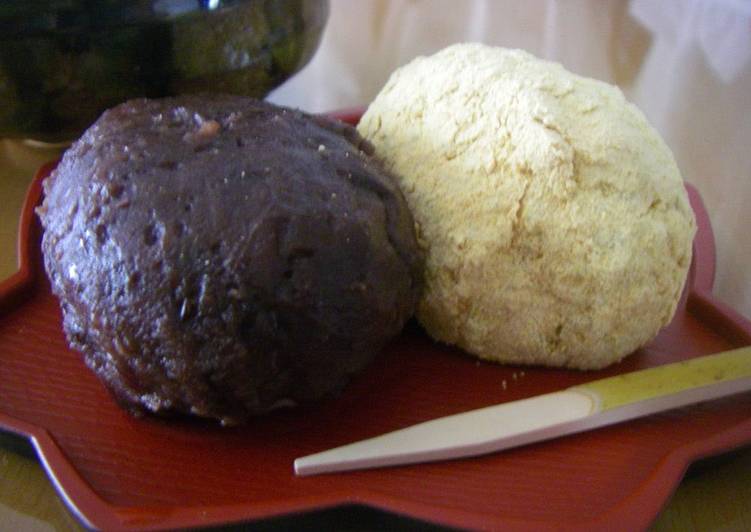Our Family Recipe for Ohagi, Passed Down Over Three Generations. Great recipe for Our Family Recipe for Ohagi, Passed Down Over Three Generations. My grandmother and mother used to make them for me. Now I am married, and since my husband loves ohagi as well, I make these quite often.
 It's been a favorite wintertime dessert for us and always included for Easter dinner and other holiday meals. —Ann Searcey, Kettering, Ohio Ohagi are traditional, sweet rice balls made for the buddhist Higan holiday in spring and fall, and usually coated with sweet kinako (soy bean powder) or sweet bean paste.
This recipe has been in my family for at least three generations, passed down from my Canadian grandmother.
It's been a favorite wintertime dessert for us and always included for Easter dinner and other holiday meals. —Ann Searcey, Kettering, Ohio Everyone in our extended family loves to cook, so I put together all of our favorite recipes in a cookbook to be handed down from generation to generation.
You can cook Our Family Recipe for Ohagi, Passed Down Over Three Generations using 6 ingredients and 9 steps. Here is how you cook that.
It's been a favorite wintertime dessert for us and always included for Easter dinner and other holiday meals. —Ann Searcey, Kettering, Ohio Ohagi are traditional, sweet rice balls made for the buddhist Higan holiday in spring and fall, and usually coated with sweet kinako (soy bean powder) or sweet bean paste.
This recipe has been in my family for at least three generations, passed down from my Canadian grandmother.
It's been a favorite wintertime dessert for us and always included for Easter dinner and other holiday meals. —Ann Searcey, Kettering, Ohio Everyone in our extended family loves to cook, so I put together all of our favorite recipes in a cookbook to be handed down from generation to generation.
You can cook Our Family Recipe for Ohagi, Passed Down Over Three Generations using 6 ingredients and 9 steps. Here is how you cook that.
Ingredients of Our Family Recipe for Ohagi, Passed Down Over Three Generations
- Prepare 250 grams of Dried azuki beans.
- Prepare 300 grams of Sugar.
- You need 1 pinch of Natural salt.
- You need 300 ml of Mochi rice.
- It's 200 ml of White rice.
- Prepare 1 of Kinako.
This recipe comes from that cookbook. It's a delicious twist on traditional potato salad. —Suzette Jury, Keene, California This recipe is a family favorite that was passed down over the generations. Grandma and Pap just ate them plain, with a fork (sometimes dipped in ketchup), but our family likes to top these burgers with cheese and serve on a hamburger bun in a the traditional way. I have also seen these referred to as Kotlety Mielone.
Our Family Recipe for Ohagi, Passed Down Over Three Generations step by step
- Rinse the adzuki beans and soak in a saucepan with enough water to cover. Bring to a boil and drain. Repeat this 2~3 times..
- Combine the beans with 5 times the amount of water in the pan and bring to a boil. Then turn down the heat to low, and cook until the beans are tender. Add water from time to time..
- This time, it took 1 hour and 40 minutes to cook the beans until they were tender. Now, you only need enough water to cover the beans. If there is too much water in the pan, discard. Then add sugar and salt. (Note: Don't add sugar before the beans become tender.) Cover and leave to stand overnight..
- The next morning, cook over low heat until there is not much water left in the pan. Make the regular white rice first. For the mochi rice, rinse and soak in hour for 1 hour, then cook in a rice cooker with the same amount of water as you'd use for regular rice..
- When the water in the pot is almost gone, stay close to the pan! Stir with a wooden spatula gently from the bottom. It's done when the adzuki beans drop slowly from the spatula. Leave to cool down. Don't worry if you think it's too soft, because it will thicken up a bit when it cools down..
- When the rice is cooked, mash while it is still hot, using a moistened wooden pestle. Mash the rice until it is still a bit lumpy. You won't waste any ingredients if you match the number of rice balls and anko portions. We always use kinako powder to use up the leftover rice..
- For anko ohagi: Put a piece of cling film on your hand and put 1 portion of anko on top. Flatten the anko. Place a rice ball on top. Wrap the anko around the rice ball..
- For kinako ohagi: Wet your hands and flatten a rice ball on your hands. Put a small portion of anko on top. Make a barrel-shaped rice ball using both hands. Coat with a loooooot of kinako powder. (We don't add any sugar to the kinako as it gets sticky after a while, but it's up to you)..
- These are our pride and joy! We make a lot to share..
There's something undeniably special about recipes that have been passed down through the generations. They've been tested, tasted and tweaked time and again until they're perfect. Organize all of the information/recipes into categories so it's easy to find. Be sure to include extra pages so more recipes can be added later! Now you're ready to present your family recipe book to a special person.